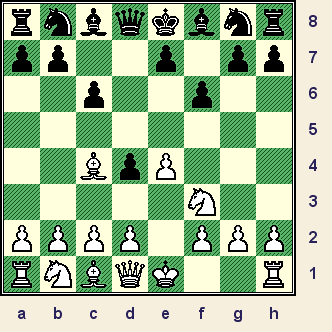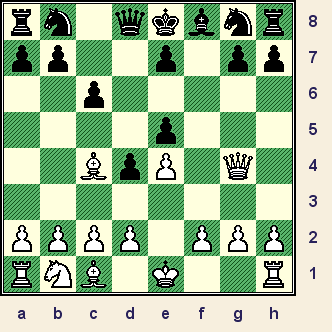All
the |
(Navigation bar
directly below.)
*******
© A.J. Goldsby, 2015.
(All rights reserved.)
****************
Click HERE
to see my
Chess Items.
****************
****************
Buy a book
from Amazon.com
(And help me out as well!)
****************
Click HERE
...
to see a list of the businesses that help to sponsor all of
my chess efforts.
A Caro-Kann Trap
(The Two Knight's Variation.)
Player # 1 (1600) - Player # 2 (1600)
|
|
|
**********
[ The main line of this variation is:
3...Bg4!?;
4.h3 Bxf3!?; 5.Qxf3, "+/=" {Diagram?}
when White probably maintains
a (very) slight advantage.
[ See MCO-14; page # 188-189,
columns # 49 through col. # 54.
{Mainly cols. # 49 - 51.}
See all applicable notes as well. ]
I must have at least 10 books on
the Caro-Kann Defense.
My favorite,
even though it is a little dated, is the
following book:
"The
Caro-Kann: Classical 4...Bf5" by GM
G. Kasparov
and
IM Aleksander Shakarov.
Copyright (c) 1984, Macmillian
Publishing Company.
{Collier?} ISBN: 0-02-011490-7
(I like this book better than many
of the other books I have
purchased
on the Caro-Kann in the last 20
years. Of course
it does not cover
anything but the move ...Bf5 on
move four.)
Another good book - whose
coverage of the Caro-Kann is
VERY
good, nearly encyclopedic, is:
"Nunn's
Chess Opening's," by GM John Nunn.
(But this book also is getting old
and really needs to be
updated.)
The latest GM example I could find
in the database was:
F. Vallejo Pons - Victor Bologan;
it Pamplona, ESP; 2002. ]
***
4.Nb1!?,
(dubious?)
Pandolfini does not comment ...
at this particular point, but this looks a little strange and unusual
to me.
(I think Ne2 is the normal
line here.)
Was White (overly) concerned that Black might push his d-pawn to d3?
White's Knight has been returned to its home square ... for no good reason, as far as I can see.
***
[ A superior way to play this line
would have been:
>/= 4.Ne2! c5!?;
5.d3!?, {Diagram?}
I like this ... although most books
condemn it as too passive.
(Supposedly it is better for White
to play Ng3 at this point,
but I am
not really 100% convinced.)
( According to theory, a better
line for White is as follows:
>/= 5.Ng3, (!)
5...Nc6; 6.Bc4 e5; 7.d3 Be7; 8.0-0 Nf6;
9.Nh4!?, {Diagram?}
GM P. Keres - GM S. Tartakower;
The 'Two Countries' Match.
(France vs. the U.S.S.R.)
Paris, FRA; 1954.
[ See ECO-B, page # 92,
lines [B10], {Filip} section # 3;
row # 16, and also note # 82. ] )
5...Nc6; 6.g3 e5; 7.Bg2 Nf6;
8.0-0 Be7; 9.c4! 0-0;
10.Ne1!? Bd7;
11.h3 Qc8; 12.Kh2 a6!?; 13.f4 b5;
14.b3,
"~" {Diagram?}
A.J. Goldsby - NM D. Barrows;
The U.S. Open, (USA); 1977.
White went on to win a long and
very difficult game.
(White's
position resembles an improved
King's Indian
Defense, but with
colors reversed.) ]
***
4...f6?!;
(Maybe - '?')
A horrid little move.
I suppose Black wants to play ...e5; but this is simply one pawn push too many! (Black also severely weakens his King-side with this move.)
[ According to one (very old) book
that I have, Black
should play:
>/= 4...c5; 5.Bc4 Nc6;
6.a3 e5; 7.d3 Be7; 8.Nbd2,
8...Nf6;
9.h3 0-0; 10.0-0, "+/= {Diagram?}
and White has a small advantage.
(No source is quoted, and I could
not find any games
in the database
from this particular position.) ]
5.Bc4!,
{See the diagram - just below.}
If Black is going to be so nice as to
send White an invitation to completely
dominate a key diagonal, (and a lot
of light-colored squares to boot);
then the first player should be polite
and simply accept.
**********
|
|
**********
[ Another trap book gives:
5.c3!? d3?!;
(Maybe - '?')
{Diagram?}
A terrible move - that is given an
exclam in another
little book!
6.Qb3!, {Diagram?}
A large improvement over the
trap in the book.
(The trap goes: </= 6.Nd4? e5; "=/+" etc.
But the
moves are so inane, I will not
reproduce
them here.)
6...e5; 7.Qc4 Bg4; 8.Qxd3 Qxd3;
9.Bxd3 Nd7;
10.Bc2,
"+/=" (Maybe - "+/") {Diagram?}
and White is simply a pawn up.
(Analysis line ... by yours truly.)
***
White could also play d3. This
move looks very harmless,
but sets
a nasty trap as well:
5.d3!? c5;
6.g3 e5?; {Diagram?}
Risk for no reason. By playing the
move ...Nc6 first,
Black avoids any
problems or sacrifices on e5.
7.Nxe5?!, {Diagram?}
The author of one trap book
praises this move.
(He gives
it an exclam.) But it is not even
clear if this
sacrifice is sound.
(Much better would be:
>/= 7.Bg2 Bd6; 8.Nbd2 Ne7; 9.Nc4 Bc7;
10.a4 0-0; "=" {Diagram?}
when Black stands no worse,
at least in my opinion.)
7...fxe5; 8.Qh5+ g6??; {Diagram?}
This move is just a blunder.
( With simple moves like:
8...Ke7; 9.Qxe5+ Kf7; 10.Qf4+ Qf6; "/+" {Diag?}
Black escapes the checks, and
comes out on top. )
9.Qxe5+ Kf7; 10.Qxh8 h6; 11.Qe5 Nc6;
12.Qf4+, "+/-"
... "and White has won enough
material to win the game."
(From: "The Little
Book of
Chess Traps.")
But the whole thing is simply unsound!! ]
*******
5...Bg4?,
Simply dreadful.
I guess the idea is Black would like to play this, then ...Nbd7; and follow this up with ...e5. (Maybe then Black will develop his King-side?)
But its too slow ... and bad to be any good. (Emanuel Lasker once said: "Knight's BEFORE Bishops." While not true all of the time - the Ruy Lopez is an obvious exception; this nugget of wisdom is right the majority of the time.)
[ Black had to try something like:
>/= 5...b5!?;
6.Bb3 a5!?; 7.a4, "+/=" when White has a small
advantage in this position. ]
6.Ne5!,
(thematic)
Simply brilliant. A beautiful and a
logical refutation to the second player's inconsistent play.
[ Or 6.h3!? Bc8!; 7.d3, "+/=" and White is still better. ]
6...fxe5[];
This is - obviously - forced.
[ Of course Black could not play: 6...Bxd1??; 7.Bf7#, which is a relatively simply mating pattern. ]
7.Qxg4, '±' (White is clearly better here.) {See the diagram - just below.}
**********
|
|
**********
7...Qd6?; (Really - '??')
{Diagram?}
Why this turkey of a move?
Pandolfini's traps are all culled from
actual play, so I bow to his knowledge
here ... but this is one silly move.
(Perhaps the idea is to prevent
White from playing Qe6?)
[ My {former} student gives the
following line ...
claiming it represents the best play, or forced
moves ...
for both sides:
>/= 7...Nd7!?;
8.Qe6 Nh6; 9.d3 Qa5+?!;
10.Bd2!?,
{Diagram?}
A simple move.
( >/= 10.Nd2!, '±' )
10...Qd8??; {Diagram?}
This is a blunder.
(Black should try ...Qb6;
... ... ...
or
possibly consider resignation!!)
11.Bxh6 gxh6??; 12.Qf7#. ]
Now White wins simply with:
8.Qc8+! Qd8; 9.Bf7+! Kxf7; 10.Qxd8, ("+/-")
{Diagram?}
and White has an overwhelming
material advantage.
***
The great teacher & author
says:
"Black makes several questionable
moves. Advancing the f-pawn weakens Black's position and wastes
time. Developing the Queen Bishop
is premature.
Defending with the
Queen fails. That's enough to lose
most chess games." - NM Bruce Pandolfini.
RELATED ZAP:
1.d4, d5; 2.c4, e6; 3.Nf3, c5; 4.dxc5, Bxc5; 5.Nbd2, dxc4; 6.Nxc4, Bxf2+; 7.Kxf2, Qxd1. ("-/+")
(Queen's Gambit Declined.)
*******
(All games - HTML code initially) Generated with ChessBase 8.0
*******
Copyright (c) A.J. Goldsby I. Copyright (c) A.J.G; 2003.
(Posted Tuesday; August 05, 2003. Last edit or save on: 07/14/2012 02:16 AM .)
1 - 0
Click HERE to go to (or return to) my HOME PAGE.
Click HERE to go to (or return to) my page on Chess Traps. (# 2.)
(Or click the "Back" button on your web browser.)
Copyright (c) A.J. Goldsby I
Copyright (©) A.J. Goldsby, 1985 - 2011.
Copyright © A.J. Goldsby, 2012. All rights
reserved.


